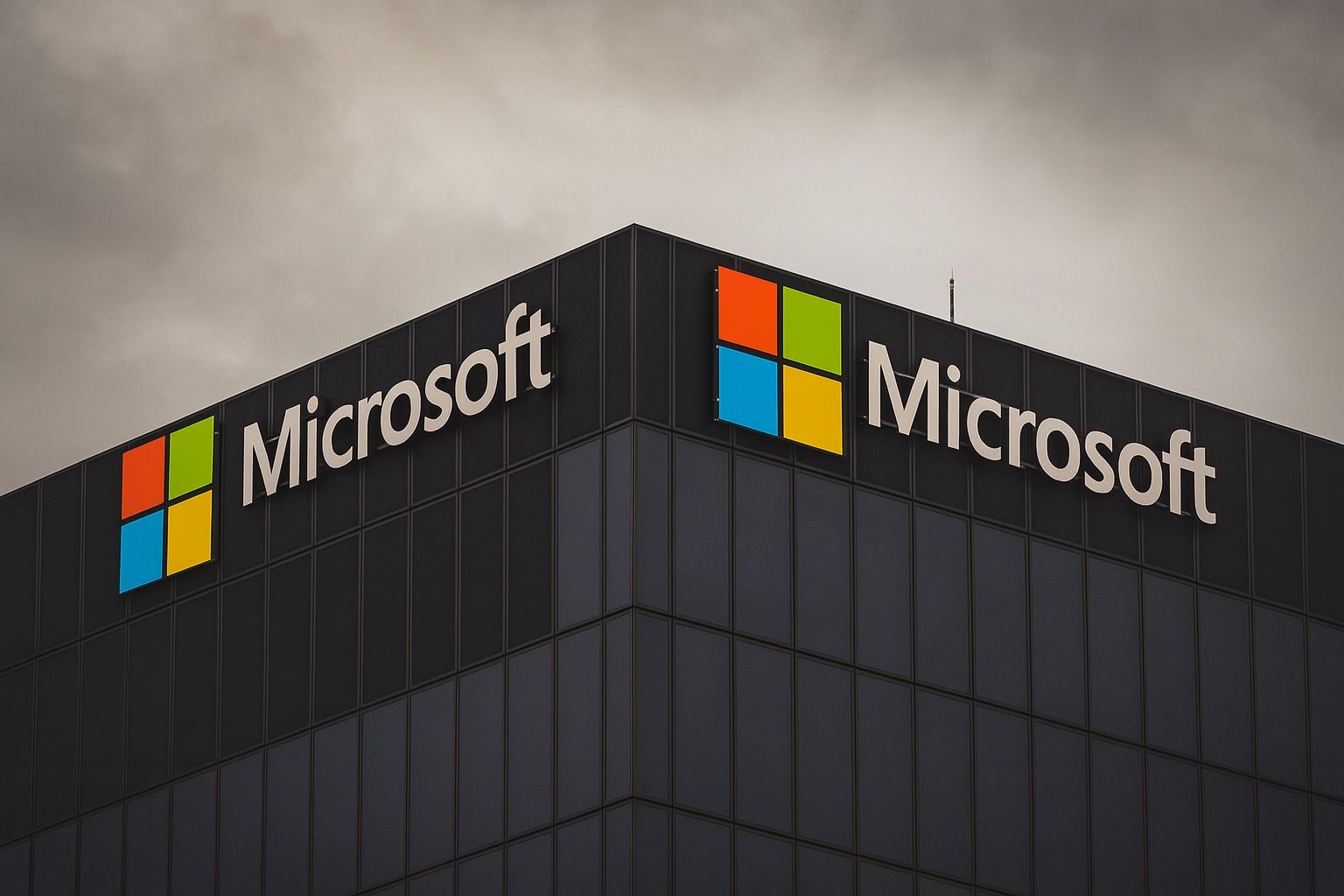Microsoft stock slipped on Thursday, November 13, 2025, as a broad tech sell‑off washed over Wall Street—even while fresh headlines around OpenAI, custom AI chips, quantum computing, and new Azure partnerships kept the long‑term AI story firmly in focus. Shares of Microsoft (NASDAQ: MSFT) closed around $503.29, down roughly 1.5% on the day, with after‑hours trading nudging the price slightly higher. [1]
Below is a breakdown of how MSFT traded today, what moved the stock, and the key Microsoft news items investors are watching right now.
Microsoft Stock Price Today: Key Numbers
As of the close on November 13, 2025:
- Closing price: about $503.29, down $7.85 (‑1.54%) on the day
- After‑hours quote: roughly $504.20 as of early evening U.S. Eastern time [2]
- Intraday range: approximately $501–$514 per share
- Today’s trading range reported by multiple feeds: low near $501.29, high around $513.50 [3]
- 52‑week range: about $344.79 (low) to $555.45 (high), putting today’s close roughly 9–10% below the 52‑week peak [4]
- Market capitalization: around $3.7–$3.8 trillion, keeping Microsoft in the global top tier by market value [5]
- Valuation: trailing price‑to‑earnings ratio in the mid‑30s, reflecting a premium multiple versus the broader market driven by AI and cloud growth expectations [6]
Trading volume sat around its recent average—into the double‑digit millions of shares—suggesting today’s move was part of a broad macro risk‑off day rather than a Microsoft‑specific panic. [7]
Big Picture: Tech Stocks Hit as Rate‑Cut Hopes Cool
Microsoft’s drop today largely mirrors what happened across the tech complex:
- The S&P 500 fell about 1.66%, the Dow roughly 1.65%, and the Nasdaq 100 more than 2%, as traders dialed back expectations for aggressive Federal Reserve rate cuts following the end of the U.S. government shutdown and mixed economic data. [8]
- AI heavyweights, including Nvidia and other large‑cap names, saw particularly sharp declines, dragging tech indices lower. [9]
In other words, MSFT isn’t falling in a vacuum. The stock is getting pulled down by a broad de‑risking in high‑multiple tech and AI names even as its own news flow remains, if anything, more constructive than negative.
MarketBeat’s “Why Is Microsoft Down Today?” summary essentially frames the move as investors balancing short‑term worries (competition in gaming, mixed feelings on product monetization, chip execution risk) against long‑term positives (AI infrastructure build‑out, new enterprise deals, and ecosystem strength). [10]
What’s Moving Microsoft Stock on November 13, 2025
1. OpenAI Chip Strategy: Using a Partner to Fix the Chip Problem
One of the most important narratives around Microsoft right now is its evolving chip strategy and how tightly it’s now intertwined with OpenAI:
- Bloomberg and other outlets report that Microsoft plans to use OpenAI’s custom AI‑chip work to accelerate its own in‑house semiconductors, effectively letting OpenAI do part of the heavy lifting on chip design. [11]
- CEO Satya Nadella has said Microsoft will work with designs from both OpenAI and its internal teams “knowing we have the IP rights”, thanks to the revised partnership structure. [12]
- Articles from crypto and finance sites highlight that Microsoft will be able to leverage OpenAI’s chip and hardware research through 2030, with access to AI models through 2032, as part of the expanded agreement. [13]
For investors, this matters because:
- It reduces Microsoft’s dependence on third‑party chips (read: Nvidia, AMD) over time, at least at the high end.
- It may speed up time‑to‑market for custom accelerators that better align with Azure’s needs.
- But it also underscores execution risk—if OpenAI’s designs or the integration process stumble, Microsoft’s own chip roadmap could be delayed.
Today’s fresh commentary around this strategy—“Microsoft’s plan to fix its chip problem is, partly, to let OpenAI do the heavy lifting”—is a key reason why MSFT stayed relatively resilient earlier in the session before macro forces took over. [14]
2. Mega‑Scale AI Infrastructure: Portugal, IREN and Sovereign AI
Microsoft’s AI ambitions are also playing out in a string of huge infrastructure announcements that remain front of mind for traders on November 13:
$10 Billion AI Data Hub in Portugal
- Reuters and Bloomberg report that Microsoft will invest about $10 billion in an AI data‑center hub in Sines, Portugal, one of the largest AI infrastructure projects in Europe. [15]
- The site will host tens of thousands of next‑gen GPUs supplied by Nvidia, tapping into Sines’ role in subsea cables and access to greener power. [16]
This reinforces two themes that matter for MSFT’s valuation:
- AI demand is real and global—Microsoft isn’t just expanding in the U.S.
- Capex is massive—projects like this weigh on near‑term free cash flow even as they support future revenue.
$9.7 Billion AI Deal with IREN to Secure Nvidia Chips
- Earlier this month, Microsoft struck a $9.7 billion, five‑year contract with data‑center operator IREN that gives it access to large volumes of Nvidia’s GB300 chips. [17]
- The structure lets Microsoft scale compute capacity via a “neocloud” partner rather than building all the data‑center space and power infrastructure itself. [18]
Investors see this as:
- A pragmatic workaround for power and real‑estate constraints that limit how fast hyperscalers can build new campuses.
- Another sign that AI infrastructure spending isn’t slowing—it’s just getting more creative.
Azure Local and Sovereign AI with Nvidia Blackwell
- A DataCenterDynamics piece details Microsoft’s expansion of Azure Local, its on‑premises/edge offering, which can now scale to hundreds of servers and includes sovereign AI capabilities using Nvidia’s RTX Pro 6000 Blackwell Server Edition GPUs. [19]
- This move directly targets customers with strict data residency and sovereignty requirements, especially in Europe.
Together, these infrastructure headlines are medium‑ to long‑term positives for Azure and Microsoft Cloud, even if they contribute to the “spending vs. margins” debate that occasionally pressures the stock.
3. Quantum Expansion: A Long‑Duration Bet in Denmark
Not all of today’s news is about near‑term AI revenue. Microsoft also pushed deeper into quantum computing:
- Microsoft is expanding its quantum facility near Copenhagen, building a second lab in Lyngby that will form its largest quantum site globally. [20]
- The company has now invested more than 1 billion Danish kroner (around $150+ million) in Denmark’s quantum ecosystem, supporting development of its Majorana‑based quantum chip aimed at reducing error rates. [21]
For the stock, this is not a short‑term catalyst, but it reinforces the narrative that Microsoft is positioning beyond today’s AI boom, building IP in quantum that could matter for drug discovery, finance, and climate modeling in the next decade or two.
4. Ecosystem & Marketplace Momentum: Azure Partners Everywhere
November 13 also brought a flurry of partner and marketplace headlines that, while not individually stock‑moving, collectively underscore Microsoft’s reach:
- Dynatrace announced a new cloud operations solution for Microsoft Azure, designed to improve AI‑driven observability and automation across large Azure deployments. [22]
- Cognizant is acquiring 3Cloud, a major Azure‑focused services provider, to create one of the largest pure‑play Azure services businesses—effectively adding more “muscles” around Microsoft’s cloud. [23]
- EPAM Systems was recognized with Microsoft’s 2025 “Innovate with Azure AI Platform” Partner of the Year award, highlighting the depth of AI solutions being built on Azure. [24]
- CloudFit Software was named Microsoft’s Global Defense & Intelligence Partner of the Year, pointing to continued cloud wins in defense and government. [25]
- A fresh post, “New in Microsoft Marketplace: November 13, 2025,” lists nearly 200 new offers—from risk management tools to AI‑powered financial applications—launching on the Azure Marketplace today. [26]
- Security vendor RSA launched RSA ID Plus for Microsoft, a phishing‑resistant identity security layer now available via Azure Marketplace that plugs directly into Microsoft Entra. [27]
If you zoom out, the pattern is clear: the Azure ecosystem is expanding in all directions—AI observability, sovereign cloud, identity security, defense, and financial services. That ecosystem growth is one reason analysts often justify Microsoft’s premium multiple.
5. Institutional Flows and Insider Sales: Mixed Signals, Same Story
Two notable institutional filings hit MarketBeat today:
- Prairie Sky Financial Group LLC trimmed its Microsoft position by about 16.9% in Q2, selling 2,824 shares and ending the quarter with 13,911 shares worth roughly $6.9 million, still its 10th‑largest holding. [28]
- Rheos Capital Works Inc., by contrast, increased its MSFT stake by 11.7% to 114,300 shares worth around $56.9 million, making Microsoft its 9th‑largest position. [29]
Both pieces also highlight sizable insider selling earlier in the quarter:
- CEO Satya Nadella sold around 149,205 shares (roughly $75 million).
- President Brad Smith sold about 38,500 shares (~$20 million). [30]
Heavy insider selling can spook some investors, but:
- These sales came after a big run‑up in the stock to record highs near $540–$555. [31]
- Microsoft continues to post strong earnings and has raised its dividend to $0.91 per quarter (annualized $3.64), with the next ex‑dividend date later in November. [32]
- Institutional ownership remains high, at around 71% of shares outstanding. [33]
Net‑net, the flows look like normal portfolio rebalancing and profit‑taking after a strong multi‑year rally, rather than a mass exodus.
6. Leveraged ETF Buzz: MSFU as a Sentiment Gauge
A Seeking Alpha article released today—“MSFU: Why This Could Be a Smart Long‑Term Bet”—spotlights the Direxion Daily MSFT Bull 2X Shares ETF (MSFU), which seeks 200% of Microsoft’s daily performance via derivatives. [34]
Key points from that coverage:
- The author argues that Microsoft remains a strong long‑term investment, even at valuations some see as rich, thanks to AI and cloud leadership. [35]
- MSFU is pitched as a way for aggressive traders to magnify gains (and losses) tied to Microsoft’s daily moves. [36]
For everyday investors, the takeaway isn’t “go buy leveraged ETFs,” but that bullish conviction on Microsoft’s long‑term story is still strong enough that specialized products are attracting attention.
Earnings and the OpenAI Deal Still Frame the Narrative
Underneath today’s noise, the anchor for Microsoft’s stock is still its most recent fiscal Q1 2026 earnings and the recast OpenAI partnership.
FY26 Q1: AI and Cloud Still in High Gear
For the quarter ended September 30, 2025, Microsoft reported: [37]
- Revenue: about $77.7 billion, up 18% year‑over‑year
- GAAP net income: roughly $27.7 billion, with GAAP EPS of $3.72
- Excluding the impact of OpenAI‑related accounting items, non‑GAAP EPS was $4.13, up 23% year‑over‑year
- Microsoft Cloud revenue:$49.1 billion, up 26%
- Intelligent Cloud (including Azure):$30.9 billion, up 28%, with Azure and other cloud services up about 40%
- The company returned $10.7 billion to shareholders via dividends and buybacks in the quarter
On the earnings call, Nadella emphasized that Microsoft is running the world’s most expansive data‑center fleet for AI, with capacity being added at “unprecedented” scale and GB300 clusters already live. He also highlighted 900 million monthly active users of AI features across Microsoft products and more than 150 million monthly users of Copilot experiences. [38]
Those numbers are what allow Microsoft to “pay” for its enormous AI capex—but they also contribute to the debate about whether the company is spending too far ahead of proven returns.
The Re‑Written OpenAI Deal: More Rights, More Risk
On October 28, Microsoft detailed the “next chapter” of its OpenAI partnership: [39]
- Microsoft now holds an investment in the new OpenAI public‑benefit corporation valued at about $135 billion, representing roughly 27% on an as‑converted diluted basis.
- Microsoft’s IP rights on OpenAI models and products now extend through 2032, including post‑AGI models, with safety guardrails.
- The agreement grants Microsoft IP rights to certain confidential research methods until 2030 or until an independent panel confirms AGI has been reached.
- OpenAI has contracted to purchase an additional $250 billion in Azure services, a staggering long‑term compute commitment—even as Microsoft loses its exclusive right of first refusal on OpenAI’s future compute.
Separate reporting suggests OpenAI has already spent around $12 billion on Azure inference, with Microsoft receiving hundreds of millions in revenue from OpenAI in the first half of 2025 under a 20% revenue‑sharing agreement. [40]
Microsoft President Brad Smith has publicly pushed back on the idea of an “AI bubble,” pointing instead to a reality where demand for AI services exceeds Microsoft’s current capacity, making infrastructure build‑out the main constraint rather than customer appetite. [41]
From an investor’s perspective, the net effect of the new OpenAI deal and the earnings backdrop is:
- More clarity and control for Microsoft over AI IP and models
- Enormous, long‑dated revenue potential from OpenAI’s Azure commitments
- Higher exposure to OpenAI’s financial health, which has sparked some concerns after reports of heavy cash burn and accounting write‑downs
Valuation Snapshot: Premium Priced, AI‑Heavy
At about $503 per share, MSFT sits: [42]
- Roughly 9–10% below its 52‑week high of $555.45
- Well above its 52‑week low of $344.79
- On a P/E in the mid‑30s, versus a high‑teens multiple for the broader S&P 500
Some analysts and commentators worry this leaves limited margin for error if AI adoption or macro conditions falter. A recent 24/7 Wall St. forecast piece, for example, modeled MSFT reaching the mid‑$560s over the next year, implying modest double‑digit upside from current levels, but also highlighted the risks of any slowdown in AI or cloud growth. [43]
In short, today’s sell‑off is happening against a backdrop of high expectations. The long‑term story hasn’t broken; it’s just being repriced in real time as rates, AI sentiment, and competitive headlines shift.
Key Risks and What to Watch Next
Looking ahead from today’s close, here are the main issues the market is watching around Microsoft stock:
- Interest‑Rate Path & Macro Data
- Markets sold off today on reduced expectations for near‑term Fed rate cuts and lingering concerns about the economic hit from the recent U.S. shutdown. Higher‑for‑longer rates tend to compress multiples on long‑duration growth names like MSFT. [44]
- AI Infrastructure Economics
- Multi‑billion‑dollar projects in Portugal and elsewhere, plus deals with IREN and “neocloud” partners, are capital‑intensive. Investors will be watching future earnings calls for evidence that AI infrastructure is translating into durable, high‑margin revenue rather than just higher depreciation. [45]
- Energy and Data‑Center Constraints
- AI data centers are bumping up against power and sustainability limits, particularly in Europe and some U.S. regions. Microsoft’s sovereign AI, Azure Local, and partnerships are partly about solving that, but constraints could still slow capacity growth and push costs up. [46]
- Competition in AI and Cloud
- AWS and Google are ramping their own AI infrastructure spends, while new chip partnerships and open‑source models erode some moats. Microsoft’s edge will depend on keeping Azure AI, Copilot, and now its own chip roadmap ahead of rivals. [47]
- Gaming & Regulatory Pressure
- Coverage of Valve’s upcoming Steam Machine and related devices paints a picture of a more competitive gaming landscape, which could pressure Xbox’s share of gamer attention over time. [48]
- At the same time, Microsoft’s scale in cloud and AI keeps it firmly in global regulators’ sights.
- OpenAI & Partner Risk
- OpenAI’s financials and governance are now deeply entwined with Microsoft’s AI roadmap. Any shock—regulatory, financial, or reputational—at OpenAI could spill over into Microsoft’s AI narrative and usage metrics. [49]
Bottom Line for Microsoft Stock on November 13, 2025
On November 13, 2025, Microsoft stock is down with the broader tech market, not because the AI story fell apart overnight, but because:
- The market is digesting less dovish rate expectations and a sharp risk‑off move in AI names. [50]
- New headlines underscore just how capital‑intensive Microsoft’s AI ambitions are—from a $10 billion Portuguese hub to multibillion‑dollar chip deals and quantum labs. [51]
- At the same time, the company continues to post strong double‑digit cloud and AI growth, deepen its OpenAI relationship, and expand an ecosystem of partners building on Azure. [52]
Whether today’s dip is a buying opportunity or a warning sign ultimately depends on your time horizon, risk tolerance, and view on AI infrastructure economics. What’s clear from today’s news flow is that Microsoft is doubling down, not backing away, from its role at the center of the AI and cloud computing stack.
This article is for informational and educational purposes only and is not investment advice or a recommendation to buy or sell any securities. Always do your own research or consult a licensed financial advisor before making investment decisions.
References
1. www.marketbeat.com, 2. www.marketbeat.com, 3. www.investing.com, 4. www.macrotrends.net, 5. finance.yahoo.com, 6. www.bloomberg.com, 7. marketchameleon.com, 8. www.nasdaq.com, 9. www.reuters.com, 10. www.marketbeat.com, 11. www.bloomberg.com, 12. www.ndtvprofit.com, 13. phemex.com, 14. finance.yahoo.com, 15. www.reuters.com, 16. www.reuters.com, 17. www.cloudcomputing-news.net, 18. www.cloudcomputing-news.net, 19. www.datacenterdynamics.com, 20. www.reuters.com, 21. www.reuters.com, 22. ir.dynatrace.com, 23. seekingalpha.com, 24. investors.epam.com, 25. news.futunn.com, 26. techcommunity.microsoft.com, 27. www.rsa.com, 28. www.marketbeat.com, 29. www.marketbeat.com, 30. www.marketbeat.com, 31. www.macrotrends.net, 32. www.marketbeat.com, 33. www.marketbeat.com, 34. seekingalpha.com, 35. stockanalysis.com, 36. seekingalpha.com, 37. www.microsoft.com, 38. www.microsoft.com, 39. blogs.microsoft.com, 40. www.theregister.com, 41. timesofindia.indiatimes.com, 42. www.macrotrends.net, 43. 247wallst.com, 44. www.nasdaq.com, 45. www.reuters.com, 46. www.datacenterdynamics.com, 47. www.bloomberg.com, 48. www.purexbox.com, 49. blogs.microsoft.com, 50. www.nasdaq.com, 51. www.reuters.com, 52. www.microsoft.com







